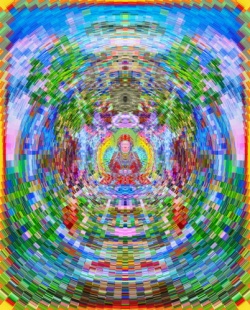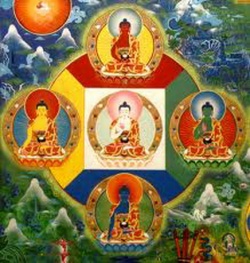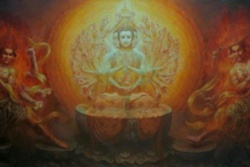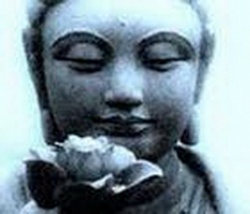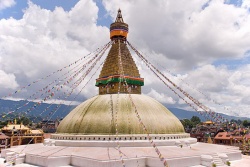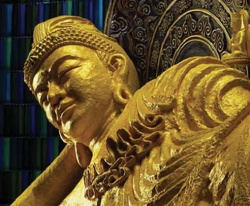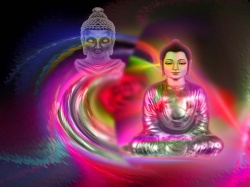Arhats and Longevity
Arhats and Longevity
By Indrajala (Jeffrey Kotyk)
As of late I have been reading part of Vasubandhu's Abhidharmakośa-bhāṣya in detail utilizing the original Sanskrit as well as the Classical Chinese translations by Paramārtha 真諦 and Xuanzang 玄奘. In addition, I have made great use of Leo M. Pruden's English translation of Louis De La Vallee Poussin's French translation and study of the Abhidharmakośa-bhāṣya. There is also a Classical Tibetan version, but unfortunately I cannot read Tibetan.
In the following section I will outline a process elaborated on in the text under the chapter on indriya which details how an Arhat increases or decreases his or her lifespan. The key thing to note here is the process first requires entry into the fourth dhyāna or meditative absorption which indeed entails that only those already quite advanced in samadhi have this ability. Furthermore, the process is one where a voluntary decline in enjoyment is exchanged for an extension in lifespan and a decline in lifespan is exchanged for an increase of enjoyment. The former is undertaken when an Arhat feels they would be of further benefit to sentient beings or to preserve the Dharma. The latter is undertaken when one sees oneself as being of little benefit to others and desires cessation.
I will provide here the Sanskrit followed by the two Classical Chinese translations penned by Paramārtha and Xuangzang respectively and finally the English translation by Poussin / Pruden.
The first paragraph explains how an Arhat transforms unripen karma, which was originally to become resultant joy, into an extension of his lifespan.
- śāstre uktam ——“kathamāyuḥsaṃskārān sthāpayati ? arhan bhikṣuḥ ṛddhimāṃścetovaśitvaṃ prāptaḥ saṅghāya vā pudgalāya vā pātraṃ vā cīvaraṃ vā anyatamānyatamaṃ vā śrāmaṇakaṃ jīvitapariṣkāraṃ vā dattvā tat praṇidhāya prāntakoṭikaṃ caturthaṃ dhyānaṃ samāpadyate|sa tasmāt vyutthāya cittamutpādayati vācaṃ ca bhāṣate ——‘yanme bhogavipākaṃ karma tadāyurvipākaṃ bhavatu ’ iti tasya yad bhogavipākaṃ tadāyurvipākaṃ bhavati| yeṣāṃ punarayamabhiprāyaḥ ——vipākoccheṣa vipacyata iti|
- 【真】《阿毘達磨俱舍釋論》卷2〈2 分別根品〉:「於阿毘達磨藏中說。云何引命行。令住阿羅漢比丘。有聖如意成通慧。至得心自在位。或於大眾。或於一人。捨施若鉢若袈裟。或隨一沙門命資糧。因此發願。入第四定遠際三摩提觀。從此定起。作如是心。說如是言。凡是我業應熟感。富樂願此業熟生我壽命。是時此阿羅漢業。應感富樂。轉生壽命。」(CBETA, T29, no. 1559, p. 174, c16-22)
- 【玄】《阿毘達磨俱舍論》卷3〈2 分別根品〉:「云何苾芻留多壽行。謂阿羅漢成就神通得心自在。若於僧眾若於別人以諸命緣衣鉢等物隨分布施。施已發願。即入第四邊際靜慮。從定起已心念口言。諸我能感富異熟業。願皆轉招壽異熟果。時彼能感富異熟業。則皆轉招壽異熟果。」(CBETA, T29, no. 1558, p. 15, b11-16)
- The Mūlaśāstra says: “How does a Bhikṣu stabilize the vital energies? An Arhat in possession of supernormal power (ŗddhimān-prāptābhijñāḥ), in possession of mastery of mind, i.e., one who is asamayavimukta, gives, either to the Sangha or to a person, things useful to life, clothing, pots, etc.: after having given these things, he applies this thought to his life; he then enters into the Fourth or prāntakoṭika Dhyāna; coming out of the absorption, he produces the thought and pronounces the words: 'May this action which should produce a retribution-in-joy [bhogavipāka] be transformed and produce a retribution-in-life [āyurvipāka]!' Then the action (the gift and the absorption) which should produce a retribution-in-joy produces a retribution-in-life.”(1)
The term “retribution-in-joy” or bhogavipāka is a combination of the terms bhoga and vipāka. The former is derived from the root verb √bhuj which has a number of meanings not limited to but including to enjoy food or carnal pleasures, to use, to possess and so on. The term bhoga itself can also mean experiencing, feeling or perception of pleasure or pain.(2) Paramārtha translated the term as fùlè 富樂. Xuanzang only uses the character fù 富. The term vipāka is perhaps better known in the expression karmavipāka where karma is volitional action and vipāka is the retribution or result of it. Hence the term bhogavipāka is interpreted as retribution as joy or pleasure. Incidentally, in the Mahāyāna the word sambhogakāya, otherwise known as the “enjoyment body” of the Buddha, also includes the term bhoga.
The other term “retribution-in-life” or āyurvipāka is derived from the terms āyus and vipāka. The word āyus is defined as life, vital power, vigour, health, duration of life or long life.(3) Thus it is clear how āyurvipāka is understood as a retribution or result of life or an extension in one's lifespan. Paramārtha appropriately rendered the term as shòumìng 壽命 and Xuanzang likewise used the character shòu 壽, which is normally rendered into English as longevity.
Having provided the opinion of the Mūlaśāstra, Vasubandhu then presents the opinion of another school.
- ta āhuḥ ——“pūrvajātikṛtasya karmaṇo vipākoccheṣam| sa bhāvanābalenākṛṣya pratisaṃvedayate ” iti|
- 【真】《阿毘達磨俱舍釋論》卷2〈2 分別根品〉:「復有餘師執。殘業果報轉熟。彼說宿生所作業。有殘果報。由修習力。引取受用。」(CBETA, T29, no. 1559, p. 174, c22-24)
- 【玄】《阿毘達磨俱舍論》卷3〈2 分別根品〉:「復有欲令引取宿業殘異熟果。彼說前生曾所受業有殘異熟。由今所修邊際定力引取受用。」(CBETA, T29, no. 1558, p. 15, b16-19)
- According to other masters, the prolonged life of an Arhat is the result of the retribution of a previous action. According to them, there is a remnant of the result of retribution-in-life which should have ripened in a previous life, but which was interrupted by death before its time. And it is the force of the absorption of the Fourth Dhyāna that attracts this remnant and makes this remnant ripen now.
It seems here the alternate opinion is that it is not the willed thought coupled with the fourth dhyāna that enables prolonged life, but simply the dhyāna itself mechanically producing that result. Poussin and Pruden state “Arhat” here, but the term does not appear in the Sanskrit or Chinese. It is perhaps that the implied reference is to an Arhat. Nevertheless, one problem that arises from such argument is that it would mean anyone, or perhaps more specifically any Arhat, attaining the fourth dhyāna or deepest of meditative absorptions, would, whether willingly or unwillingly, prolong their lifespan as a rather mechanical resultant process. The Mūlaśāstra actually is more reasonable as it specifically states the Arhat must attain the fourth dhyāna and then will the transformation of vipāka for the desired result to occur.
Vasubandhu then continues his quotation of the Mūlaśāstra.
- kathamāyuḥsaṃskārānutsṛjati ? tathaiva dānaṃ dattvā praṇidhāya prāntakoṭikaṃ caturthaṃ dhyānaṃ samāpadyate ——‘yanme āyurvipākaṃ tad bhogavipākaṃ bhavatu ’ iti|tasya tathā bhavati|
- 【真】《阿毘達磨俱舍釋論》卷2〈2 分別根品〉:「云何棄捨命行。如此捨施發願。入第四定遠際三摩提觀。從此定起。作如是心。說如是言。凡是我業應熟感壽命。願此業熟生我富樂。如彼欲樂。如此轉熟。」(CBETA, T29, no. 1559, p. 174, c24-28)
- 【玄】《阿毘達磨俱舍論》卷3〈2 分別根品〉:「云何苾芻捨多壽行。謂阿羅漢成就神通得心自在。於僧眾等如前布施。施已發願。即入第四邊際靜慮。從定起已心念口言。諸我能感壽異熟業。願皆轉招富異熟果。時彼能感壽異熟業。則皆轉招富異熟果。」(CBETA, T29, no. 1558, p. 15, b19-23)
- [The Mūlaśāstra continues] “How does a Bhikṣu cast off the vital energies? An Arhat in possession of supernormal powers ... enters into the Fourth Dhyāna ... ; coming out of this absorption, he produces the thought and pronounces these words: 'May the actions that should produce a retribution-in-life be transformed and produce a retribution-in-joy!' Then the action that should produce a retribution-in-life produces a retribution-in-joy.”
The term here “vital energies” is āyuḥsaṃskāra. The word saṃskāra itself is usually translated as karmic formation and is the fourth of the five skandhas or aggregates (the others being form, sensations, perceptions and consciousnesses) which conventionally make up a person. The term āyuḥsaṃskāra, like āyurvipāka, contains the word āyus which as stated above means life or longevity. Hence the term means the karmic formation of longevity, or as Poussin has translated “vital energies”.
Just as outlined above but here abbreviated, the Arhat commits a chartiable act and upon returning from a the fourth dhyāna, wills in his mind and verbally announces that whatever previous actions that would produce an extension in his life (āyurvipāka) be transformed and produce additional joy (bhogavipāka). Essentially what this entails is a sacrifice of longevity in exchange for additional enjoyment. However, this does not mean the Arhat is addicted to sensory pleasures and would rather have those than live longer. This is merely a mechanical process whereby one's life is shortened by willingly transforming and diverting one's unripe karma from longevity into enjoyment.
From here the question arises how this process works. Vasubandhu presents two opinions on the matter.
- bhadantaghoṣakastvāha——“tasminneva āśraye rūpāvacarāṇi mahābhūtāni dhyānabalena sammukhīkarotyāyuṣo ’nukūlāni vairodhikāni ca|evamāyuḥsaṃskārān sthāpayati, evamutsṛjati ”iti|
- 【真】《阿毘達磨俱舍釋論》卷2〈2 分別根品〉:「大德瞿沙說。於自依止中。由定力。引色界四大令現前。能隨順壽命。或相違四大。由如此方便。引命行令住。及以棄捨。」(CBETA, T29, no. 1559, p. 174, c28-p. 175, a1)
- 【玄】《阿毘達磨俱舍論》卷3〈2 分別根品〉:「尊者妙音作如是說。彼起第四邊際定力引色界大種令身中現前。而彼大種或順壽行或違壽行。由此因緣或留壽行或捨壽行。」(CBETA, T29, no. 1558, p. 15, b23-27)
- The Bhadantaghoṣaka said: By the force of the prāntakoṭika Dhyāna that this Arhat has produced, the primary elements of Rūpadhātu are attracted and introduced into his body. These primary elements are favorable to, or contrary to, the vital energies [āyuḥsaṃskāra]. It is in this manner that the Arhat prolongs or casts off his life.
The opinion of the Sauntrāntika is then presented:
- evaṃ tu bhavitavyam——samādhiprabhāva eva sa teṣāṃ tādṛśo yena pūrvakarmajaṃ sthitikālāvedhamindriyamahābhūtānāṃ vyāvarttayanti, apūrvaṃ ca samādhijamāvedhamākṣipanti|tasmānna tajjīvitendriyaṃ vipākam, tato ’nyat tu vipākaḥ|
- 《阿毘達磨俱舍釋論》卷2〈2 分別根品〉:「應如此成。諸阿羅漢。有如此定自在力。由此力宿業所生。諸根四大。引住時量。皆悉迴轉。先未曾有三摩提引住時量。今則引接。是故如此壽命非果報。異此名果報。」(CBETA, T29, no. 1559, p. 175, a2-5)
- 《阿毘達磨俱舍論》卷3〈2 分別根品〉:「應如是說。彼阿羅漢由此自在三摩地力轉去曾得宿業所生諸根大種住時勢分。引取未曾定力所起諸根大種住時勢分。故此命根非是異熟。所餘一切皆是異熟。」(CBETA, T29, no. 1558, p. 15, b27-c1)
- Along with the Sauntrāntikas, we say that the Arhats, through their mastery in absorption, cause the projection of the constitutive primary elements of the organs for a certain period of duration, a projection due to previous actions, to cease; inversely, they produce a new projection, born of absorption. Thus the vital organ, in the case of the prolonged life of an Arhat, is not retribution. But in other cases, it is retribution.
Finally, it begs to ask why would an Arhat shorten or extend their lifespan?
- Kimarthamāyuḥsaṃskārānadhitiṣṭhanti? parahitārtham, śāsanasthityarthaṃ ca|te hyātmanaḥ kṣīṇamāyuḥ paśyanti, na ca tatrānyaṃ śaktaṃ paśyanti| atha kimarthamutsṛjanti? alpaṃ ca parahitaṃ jīvite paśyanti rogādibhūtaṃ cātmabhavam|
- 【真】《阿毘達磨俱舍釋論》卷2〈2 分別根品〉:「阿羅漢人。何因發願引命行令住。或為利益他。或為令正法久住。是諸阿羅漢。已見自身壽命將盡。於此二中不見他有此能復以何因棄捨壽命。於有命時。見利益他事少。自身疾苦所逼如偈言。修梵行已竟 聖道已善修 由捨命歡喜 如人病得差」(CBETA, T29, no. 1559, p. 175, a6-12)
- 【玄】《阿毘達磨俱舍論》卷3〈2 分別根品〉:「彼阿羅漢有何因緣留多壽行。謂為利益安樂他故。或為聖教久住世故。觀知自身壽行將盡。觀他無此二種堪能。復何因緣捨多壽行。彼阿羅漢自觀住世於他利益安樂事少。或為病等苦逼自身。如有頌言。梵行妙成立 聖道已善修 壽盡時歡喜 猶如捨眾病」(CBETA, T29, no. 1558, p. 15, c2-9)
- Why does the Arhat prolong his vital energies? For two reasons: with a view to the good of others, and with a view to the longer duration of the Dharma. He sees that his life is going to end; he sees that others are incapable of assuring these two ends. Why does the Arhat cast off his vital energies? For two reasons: he sees that his dwelling in the world has only a small utility for the good of others, and so sees himself tormented by sickness, etc. As the stanza says: “If the religious life has been well practiced, and the Way well cultivated, at the end of his life, he is happy, as at the disappearance of sickness.”
We should be mindful that the Abhidharmakośa-bhāṣya is a Śrāvakayāna and not Mahāyāna text. That being said, this particular section in a sense helps to explain the causal process behind mantras. In the aforementioned case, the Arhat, with fine and well developed mental stamina, summons a thought directed towards a certain effect and verbally states it. Likewise with a mantra one cultivates single pointed concentration, summons a thought directed towards a certain effect and verbally recites a short verse which represents it. The process seems to be identical. One thing to be stressed here is the emphasis placed on mental stamina or fitness. In the case of the Arhat, he must have mastery of the fourth dhyāna to successfully manipulate his lifespan. Likewise, it is my understanding of mantras that concentration of the practitioner affects their efficacy. Again, both processes work on the same principle.
I imagine some readers might ask what bearing all this has in reality. What is the practical aspect of all this? I suppose the only appropriate answer is that one must attain mastery of the fourth dhyāna and only then is one in an actual position to verify the worth of such claims. Failing that, deferring to the testimony of a valid authority is possible, but will probably be unsatisfactory to most. We must keep in mind that this is not science, but by definition religion. The only way to verify whether it is really possible to extend or shorten one's lifespan through meditative absorption and willed thought is by attaining the state of an Arhat. In simpler terms we might see some hint of validity in such claims when we consider how the mental state of an individual can affect quite visibly their ageing process. Those who are weary and full of stress quickly turn grey and rapidly suffer the degeneration of mind and body. In contrast we see that those individuals who are calm, without stress and maintain good mental hygiene age slower and on the surface appear healthier. In any case, the effects of long and hard meditation are slowly being documented in the scientific community. If you are interested in the seemingly supernormal effects of meditation, I recommend the following article in the Harvard Gazette which outlines the documented effects of Tum Mo meditation (04.08.2002):
Meditation changes temperatures: Mind controls body in extreme experiments
By William J. Cromie
Footnotes
